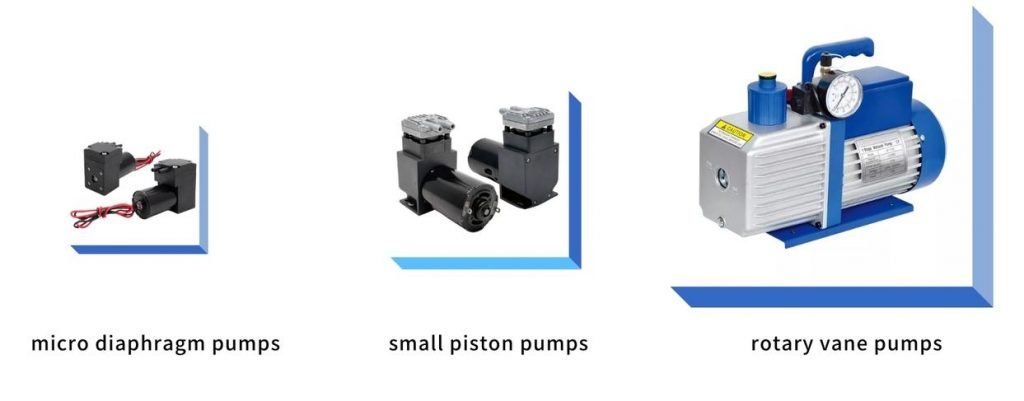
Introduction
Micro vacuum pumps are small, lightweight devices that generate a vacuum by removing gas or air from a sealed system. They have gained widespread use in a variety of industries due to their ability to operate in small, confined spaces, as well as their low power consumption which makes them energy-efficient and cost-effective. These features make micro vacuum pumps an essential component in many automatic systems, including pick and place systems, packaging machines, and robotics. In these applications, micro vacuum pumps play a crucial role in automating processes and improving efficiency. Prior to the development of micro vacuum pumps, manual labor was often required to perform many of the tasks that these pumps can now handle automatically. The use of micro vacuum pumps has revolutionized many industries, making it possible to automate processes that were previously too difficult or costly to automate.
In this article, we will explore the different types of micro vacuum pumps, their advantages in automatic systems, and their various applications.

Types of micro vacuum pumps
There are several types of micro vacuum pumps available, each with its own unique design and operating principles. The most common types of micro vacuum pumps include micro diaphragm pumps, small piston pumps, and rotary vane pumps.
| Micro diaphragm pumps | Micro diaphragm pumps use a flexible diaphragm to move the gas or air out of the system. The diaphragm is typically made of a flexible material, such as rubber or silicone, and is attached to a frame or plate. As the diaphragm moves back and forth, it creates a vacuum that draws the gas or air out of the system. Diaphragm pumps are typically quiet, energy-efficient, and easy to maintain, making them a popular choice for many applications. They are often used in a variety of industries, including medical, dental, and laboratory settings. |
| Small piston pumps | Small piston pumps use a reciprocating piston to move the gas or air out of the system. The piston is a cylindrical component that moves back and forth inside a cylinder. As the piston moves back and forth, it creates a vacuum that draws the gas or air out of the system. Piston pumps are often more powerful than diaphragm pumps and are suitable for applications that require high flow rates. They are typically used in applications where high pressure and flow are required. Piston pumps are also commonly used in industrial and manufacturing settings, as well as in the medical and dental fields. |
| Rotary vane pumps | Rotary vane pumps are a type of positive displacement pump that use a rotating vaned rotor to move gas or air. They are known for their durability and long lifespan compared to other types of micro vacuum pumps. They work by using an eccentrically mounted rotor with a number of vanes that rotate within a cylindrical housing. As the rotor turns, the vanes slide outwards and create a sealed chamber. The rotation of the rotor then causes a decrease in pressure within the sealed chamber, which causes the gas or air to flow into the pump. The gas or air is then expelled out of the pump as the vanes move back towards the center of the rotor. Rotary vane pumps are commonly used in a variety of applications, including vacuum pumping, air compression, and fluid transfer. |
Advantages of using micro vacuum pumps in automatic systems
There are several advantages to using micro vacuum pumps in automatic systems:
- Compact size: Micro vacuum pumps are small in size, making them easy to integrate into small, confined spaces in automatic systems.
- Low power consumption: These pumps have low power consumption, making them energy-efficient and cost-effective to operate.
- High reliability: Micro vacuum pumps have a high level of reliability and can operate for long periods of time without requiring frequent maintenance.
- Quiet operation: Many types of micro vacuum pumps, such as diaphragm pumps, operate quietly, making them suitable for use in noise-sensitive environments.
- Ease of maintenance: These pumps are generally easy to maintain and have simple designs, making them straightforward to service and repair.

Applications of micro vacuum pumps in automatic systems
Micro vacuum pumps are widely used in a variety of automatic systems, including:
- Pick and place systems: These pumps are used to move and manipulate small objects, such as electronic components or pharmaceutical pills.
- Packaging machines: Micro vacuum pumps are used to create a vacuum seal around packages to protect their contents.
- Robotics: These pumps are used to enable the manipulation of small objects and the movement of robotic arms.
- Automated assembly lines: Micro vacuum pumps can be used to transport and position small parts during the manufacturing process.
- Medical devices: These pumps are commonly used in medical devices such as suction pumps and ventilators.
- Analytical instruments: Micro vacuum pumps are used in analytical instruments such as mass spectrometers to generate a vacuum for sample introduction.
Maintenance and troubleshooting
Proper maintenance is essential to ensure the optimal performance of micro vacuum pumps. Some basic maintenance tasks that you can perform include:
- Cleaning the pump: Regularly cleaning the pump can help to prevent the build-up of dust and debris, which can affect the performance of the pump.
- Checking for wear and tear: Inspecting the pump regularly for signs of wear and tear can help to identify potential problems before they become serious.
- Replacing worn or damaged parts: If you notice any worn or damaged parts, it is important to replace them as soon as possible to avoid further damage to the pump.
- Following the manufacturer's recommended maintenance schedule: Each manufacturer will have its own recommended maintenance schedule for its pumps. It is important to follow this schedule to ensure that the pump is properly maintained.
If you experience any issues with your micro vacuum pump, there are several troubleshooting techniques that you can try. These include:
- Checking for clogs or leaks: Clogs or leaks can prevent the pump from functioning properly. Check for any blockages or leaks and take steps to address them if necessary.
- Checking the power supply: Make sure that the pump is properly connected to a power source and that the power supply is functioning properly.
- Verifying that the pump is properly connected to the system: Check to make sure that the pump is properly connected to the system and that there are no loose connections.
If these techniques do not resolve the issue, it may be necessary to consult the manufacturer's troubleshooting guide or seek the assistance of a professional.
Future developments in micro vacuum pump technology
As technology continues to advance, it is likely that we will see further developments in micro vacuum pump technology in the future. Some potential areas of development include:
- Increased efficiency and power: Future micro vacuum pumps may be designed to operate more efficiently and have higher pumping speeds, allowing them to handle larger volumes of gas or air.
- Improved durability: Micro vacuum pumps may be designed with more durable materials and construction methods, allowing them to have a longer lifespan.
- Enhanced control and precision: Future micro vacuum pumps may have improved control systems that allow for more precise regulation of vacuum pressure and flow.
- Miniaturization: There may be further miniaturization of micro vacuum pump design, allowing for even smaller and more compact pumps that can be easily integrated into a wider range of systems.
- Alternative energy sources: There may be the development of micro vacuum pumps that operate using alternative energy sources such as solar power or fuel cells.
- Enhanced connectivity: Future micro vacuum pumps may have enhanced connectivity features such as Bluetooth or Wi-Fi, allowing them to be easily integrated into and controlled by automation systems.
Conclusion
micro vacuum pumps are oil-free, maintenance-free, small, efficient devices that are commonly used in a wide range of applications, including automatic systems such as pick and place systems, packaging machines, and robotics. They offer a number of advantages, including their compact size, low power consumption, and high reliability. Proper maintenance and troubleshooting techniques can help to ensure that your micro vacuum pump performs optimally and has a long lifespan.
As technology continues to advance, it is likely that we will see further developments in micro vacuum pump technology. These developments may include improvements in the efficiency and power of the pumps and new designs that allow for even more compact size and ease of integration into automatic systems. It is important for those working with micro vacuum pumps to stay up-to-date on the latest developments in order to take advantage of these advancements and ensure the optimal performance of their systems.

Purchasing guide
Shenzhen boden technology development co., ltd. (brand: BODENFLO) a reputable manufacturer of micro vacuum pumps. When shopping for a micro vacuum pump, it is important to carefully evaluate your needs and do thorough research to ensure that you select a pump that is suitable for your specific application. Some things to consider include the size and power requirements of the pump, the type of gas or fluid that it will be used to move, and the specific application for which it will be used. It is also important to consider the manufacturer's reputation for reliability and performance. BODENFLO is a manufacturer of micro vacuum pumps, and it may be helpful to consult with them or do further research online to learn more about the products they offer and how they may meet your needs.


